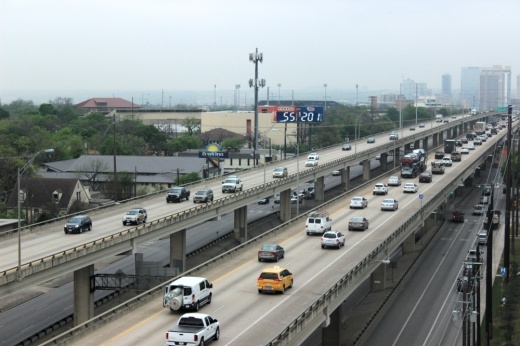I-35 is one of 15 highways the CNU highlighted in its report released June 1 alongside highways such as I-345 in Dallas, I-5 in Seattle and the Brooklyn-Queens Expressway in New York. This is the seventh report the CNU has released since the project began in 2008. I-35's first appearance came in the last report, issued in 2019.
The report highlights ideas to remove highways in each of the communities it features, including the Reconnect Austin plan to bury a section of I-35 and cover it with a cap as well as the Rethink35 proposal to replace I-35 with a boulevard.
"Everyone in Austin agrees that Interstate 35 doesn't work. The highway was built to act as a chasm between downtown and communities of color in East Austin, and is the city's most dangerous corridor for pedestrians," the report said.
The Texas Department of Transportation is set to begin construction work on a $4.9 billion project to reconstruct I-35 through Central Austin in 2025—the first major project on that stretch of road since the 1970s. Final design decisions will not come on that project until 2022, but many city leaders and community members have pushed back against the project as it stands, arguing it does not take the needs of nearby residents into account or consider the highway's history as a racial and economic barrier.
"They’re looking at a road, and we’re looking at history," said Linda Guerrero, a lifelong Austin resident and co-chair of a working group built to amplify the voice of the community as the project comes together.
For more on this project, read Community Impact Newspaper's cover story from our Central Austin edition in April.
Study: Commutes to work in Central Texas have dropped by nearly 60% from before the pandemic to March
Austin drivers have likely noticed rush-hour congestion starting to return to city streets.However, a study by Movability, a Central Texas transportation management association, and Texas State University found the number of employees commuting to work five days a week or more fell by 58% from before the pandemic to March.
More than half of the 1,551 survey respondents were government employees. Movability Communications Manager Kate Harrington said there may be more opportunities for government agencies to explore permanent telework opportunities. Travis County leaders have said publicly they hope to keep 75% of county employees who are able to work from home in permanent teleworking positions.
“The fact that so many people are still not going back to five days a week in the workplace means for a lot of employers, [telecommuting] has worked,” Harrington said.
Texas Department of Transportation names new director
Marc Williams took over as the Texas Department of Transportation's 22nd executive director June 1, replacing James Bass, who left the position to become the new executive director of the Central Texas Regional Mobility Authority.Williams has worked at TxDOT since 2012, first as director of planning then as deputy director.
"Marc brings a wealth of knowledge and a deep understanding of the challenges and opportunities we face going forward and is an excellent person to lead the 12,000 women and men of TxDOT," Texas Transportation Commission Chair J. Bruce Bugg said after the commission voted last week to lift the deputy from Williams' title.It is humbling and an honor to start this morning as the 22nd executive director @TxDOT I can't think of any better team of women and men to work alongside! pic.twitter.com/94bsXXAVUW
— Marc Williams (@TxDOTCEO) June 1, 2021
Bass, who was announced as the Mobility Authority's next executive director in January, had worked for TxDOT since 1985 and was named executive director in 2016. He is the Mobility Authority's second-ever executive director, replacing Mike Heiligenstein, who had led the organization since 2003.





